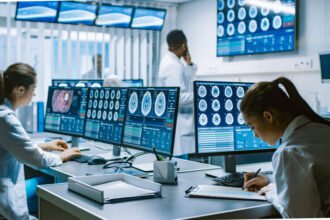Rapidly advancing technology in the healthcare industry is changing the way patients approach everything from diagnostic tests to ongoing healthcare treatments. New products and systems hit the market every year, giving patients an increasing level of control over their healthcare needs, while freeing up doctors to provide more and less invasive treatments.
From a bionic suit that eases the workload of physical therapists, to needle-free glucose monitors that transmit data wirelessly, these cool technologies are helping patients and doctors alike to approach healthcare in a whole new way.
Wearable Bionics for Patients with Paralysis
Like something out of a Sci-fi movie, Esko’s bionic suit lets patients with minimal forearm strength and complete lower body paralysis stand up and walk. This technology uses sensors that are activated by shifts in the user’s weight. It can help patients with rehabilitation in a radical new way.
The suit provides weight-bearing exercises, gait training, and more. Several walk modes are available, so the programming progresses along with the patient. The bionics device fits easily over the patient’s clothing, and therapists can adjust the suit for each new patient in as little as five minutes.
Video Observation for Tuberculosis Patients
Daily mediations are so important for tuberculosis patients that traditional treatment regiments often involve in-person observation of each patient’s daily dose. This requires hours of driving time for the health department employees who have to visit patients to watch them take their medications.
A prototype system known as Video Directly Observed Therapy, or VDOT, offers an intriguing solution. With this app, patients can video themselves taking their medications and submit the videos to their health department. This saves time, gas, and expenses for department employees. Patients find the system a vast improvement as well, as it allows them more privacy.
Verizon has partnered with UC San Diego to provide funding and technology go help scale this program to a national level. The innovative provider of fast and reliable FiOS technology is using its HIPAA-enabled cloud to streamline the VDOT system and offer this solution to health departments nationwide.
Non-invasive Scans for Suspicious Moles
Melanoma is the deadliest form of skin cancer, but cancerous moles often look strikingly similar to those that are harmless. Most patients have to undergo an invasive biopsy to find out whether an unusual mole is dangerous, but MelaFind technology is working to change that. This optical scanner allows doctors to examine lesions at 10 electromagnetic wavelengths using technology originally developed for missile navigation for the Department of Defense.
While the device won’t conclusively diagnose a cancerous lesion, it’ll provide doctors with valuable information that’ll help them determine whether a biopsy is necessary.
An Electronic Headband for Migraine Sufferers
The Cefaly electromagnetic headband for migraine sufferers won FDA approval in 2014. This futuristic device stimulates the trigeminal nerve endings in the forehead to help prevent migraine headaches. Regular stimulation of this nerve is supposed to prevent future headaches. In a recent study, slightly more than half of the participants were satisfied enough with the device to buy one. While the technology doesn’t offer a guaranteed solution for migraines, it’s relatively risk-free, making it a refreshing change for patients who are tired of trying traditional medications.
Blood Glucose Monitoring Without Needles
Ideally, diabetes patients should check their blood glucose levels three or four times a day, according to the American Diabetes Association. In reality, most patients check their blood sugar less than twice a day. The process of regular finger pricks is a pain – literally – that most patients want to avoid. This is where continuous glucose monitoring comes in.
Echo Therapeutics’ technology uses a transdermal biosensor to continuously check blood sugar levels, reading them once a minute. The sensor then triggers an alarm when levels are outside the normal range so patients can act fast.
Keep your eye on these fresh and exciting healthcare developments to see where healthcare technology will take us in the future. These trends are only the beginning of untold developments waiting for us in the future. These future innovations and inventions need to be patented, visit this link www.vimeo.com/88332381 for more information how to protect your new idea.





